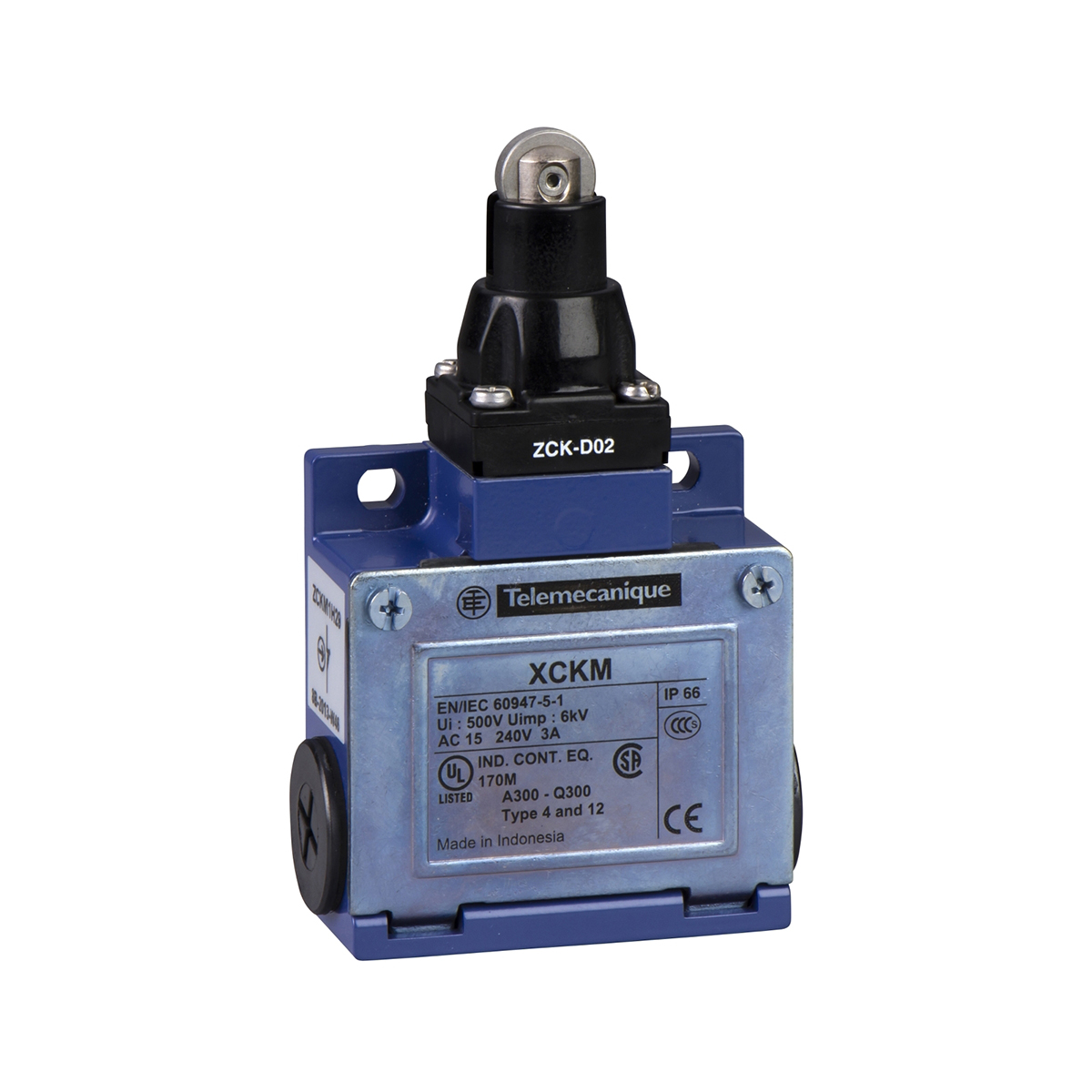لیمیت سوئیچ اشنایدر الکتریک فلزی قرقره ای فشاری
لیمیت سوئیچ اشنایدر الکتریک
کاربرد لیمیت سوئیچ
کاربرد لیمیت سوئیچ ها مختلف است و ویژگی های منحصر به فردی دارند که باعث می شود در محیط های مختلف قابل استفاده باشند برای نمونه این ویژگی ها عبارتند از استحکام، نصب آسان و اطمینان به عملکرد آنها.
range of product |
OsiSense XC
|
|
|---|---|---|
| series name |
Standard format
|
|
| product or component type |
Limit switch
|
|
| device short name |
XCKM
|
|
| body type |
Fixed
|
|
| head type |
Plunger head
|
|
| material |
Metal
|
|
body material |
Zamak
|
|
| fixing mode |
By the body
|
|
| movement of operating head |
Linear
|
|
| type of operator |
Spring return roller plunger metal
|
|
| type of approach |
Lateral approach, 2 directions
|
|
| cable entry |
3 entries tapped for Pg 11 cable gland
|
|
| number of poles |
2
|
|
| contacts type and composition |
1 NC + 1 NO
|
|
| contact operation |
Snap action
|
switch actuation |
By 30° cam
|
|
|---|---|---|
| electrical connection |
Screw-clamp terminals, clamping capacity: 1 x 0.34…2 x 1.5 mm²
|
|
| contacts insulation form |
Zb
|
|
| number of steps |
1
|
|
| positive opening |
With
|
|
| positive opening minimum force |
36 N
|
|
| minimum force for tripping |
12 N
|
|
| minimum actuation speed |
0.01 m/min
|
|
| maximum actuation speed |
0.5 m/s
|
|
| contact code designation |
A300, AC-15 (Ue = 240 V), Ie = 3 A conforming to EN/IEC 60947-5-1 appendix A
Q300, DC-13 (Ue = 250 V), Ie = 0.27 A conforming to EN/IEC 60947-5-1 appendix A |
|
| [Ithe] conventional enclosed thermal current |
10 A AC
|
|
| [Ui] rated insulation voltage |
300 V conforming to UL 508
500 V (pollution degree 3) conforming to IEC 60947-1 300 V conforming to CSA C22.2 No 14 |
|
| maximum resistance across terminals |
25 MOhm conforming to IEC 60255-7 category 3
|
|
| [Uimp] rated impulse withstand voltage |
6 kV IEC 60664
6 kV IEC 60947-1 |
|
| short-circuit protection |
10 A cartridge fuse, type gG
|
|
| electrical durability |
5000000 cycles, DC-13, inductive load type, 120 V, 4 W, operating rate <60 cyc/mn, load factor: 0.5 conforming to IEC 60947-5-1 appendix C
5000000 cycles, DC-13, inductive load type, 24 V, 7 W, operating rate <60 cyc/mn, load factor: 0.5 conforming to IEC 60947-5-1 appendix C 5000000 cycles, DC-13, inductive load type, 48 V, 10 W, operating rate <60 cyc/mn, load factor: 0.5 conforming to IEC 60947-5-1 appendix C |
|
| mechanical durability |
20000000 cycles
|
|
| width |
64 mm
|
|
| height |
64 mm
|
|
| depth |
30 mm
|
|
| net weight |
0.255 kg
|
|
| terminals description ISO n°1 |
(21-22)NC
(13-14)NO |
| shock resistance |
50 gn for 11 ms conforming to EN/IEC 60068-2-27
|
|
|---|---|---|
| vibration resistance |
25 gn (f= 10…500 Hz) conforming to EN/IEC 60068-2-6
|
|
| IP degree of protection |
IP66 conforming to EN/IEC 60529
|
|
| IK degree of protection |
IK05 conforming to EN 50102
|
|
| electrical shock protection class |
Class I conforming to IEC 61140
Class I conforming to NF C 20-030 |
|
| ambient air temperature for operation |
-25…70 °C
|
|
| ambient air temperature for storage |
-40…70 °C
|
|
| protective treatment |
TC
|
|
| product certifications |
UL
CSA CCC |
|
| standards |
IEC 60947-5-1
CSA C22.2 No 14 IEC 60204-1 EN 60947-5-1 UL 508 EN 60204-1 |
| Unit Type of Package 1 |
PCE
|
|
|---|---|---|
| Number of Units in Package 1 |
1
|
|
| Package 1 Weight |
274 g
|
|
| Package 1 Height |
3.4 cm
|
|
| Package 1 width |
6.5 cm
|
|
| Package 1 Length |
14.7 cm
|
| Sustainable offer status |
Green Premium product
|
|
|---|---|---|
| EU RoHS Directive |
Pro-active compliance (Product out of EU RoHS legal scope)
EU RoHS Declaration |
|
| Mercury free |
Yes
|
|
| RoHS exemption information |
Yes
|
|
| Environmental Disclosure |
Product Environmental Profile
|
| Warranty |
18 months
|
|---|


